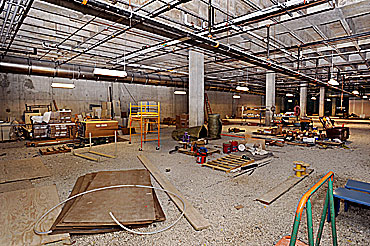AMES, Iowa - Just imagine what this will do for Iowa State University's chemistry department, Keith Woo said again and again during a recent tour of the $78 million Hach Hall that opens when the fall semester begins Aug. 23.
He said it as soon as he walked in the main entrance of the three-story building. He said it as he showed off the new teaching labs. He said it as he walked through the new research areas. And he said it as he pointed out the new faculty offices and meeting rooms.
"This facility will allow us to recruit the best students and the best faculty," said Woo, professor and associate chair of chemistry.
And so, said Jacob Petrich, professor and chair of chemistry, "We are extremely grateful to the state of Iowa, many private donors, the Carver Trust and, of course, the Hach family for providing us the means to construct this outstanding, state-of-the art facility. Hach Hall is an outstanding facility that not only provides the finest infrastructure for teaching and research, but is also as environmentally friendly as a scientifically intensive building can be."
Woo's recent tour of Hach Hall started in the big and open lobby area on the building's west side - complete with chemistry-themed art by Norie Sato of Seattle. He said the space will be a perfect place for department events, poster sessions and award banquets.
The department has had to find other places across campus for its events and celebrations. Woo said there just aren't appropriate public spaces in the department's home base of Gilman Hall, a building constructed in 1914.
Moving on, just a few steps from the lobby, Woo pointed to two big labs on either side of the building's center hallway.
These are organic chemistry teaching labs large enough for 28 students at a time, Woo said. Just outside the labs are teaching rooms for teachers and students to discuss experiments. And next door is an instrument room that gives students access to sophisticated technology, including nuclear magnetic resonance, infrared and ultraviolet-visible spectrophotometry equipment.
A few more steps down the hall are smaller teaching labs for chemistry, biochemistry and chemical engineering majors.
"These facilities will really improve the undergraduate chemistry learning experience," Woo said.
Next stop was the building's basement, where research programs in analytical and physical chemistry are moving in. The north half of the building will house labs for existing research programs, such as the one led by Klaus Schmidt-Rohr, a professor of chemistry at Iowa State and a senior chemist for the U.S. Department of Energy's Ames Laboratory.
Schmidt-Rohr - who uses solid-state nuclear magnetic resonance technology to study the physical chemistry of polymers and nanocomposites and to analyze complex organic matter - was in the lab preparing for next month's move. He had already used chalk on the floor to mark the new location of his instruments.
Schmidt-Rohr said the new space is very attractive because it makes it possible for his research group to move out of space that's barely big enough for his instruments. And the new space allows the group to pursue grants for bigger, more powerful instruments.
"Here," Schmidt-Rohr said, "we have all the space we need."
Across from new research labs, the chemistry department has left a huge cavern of a room unfinished. Woo explained the space will be reserved for new faculty who will have the ability to design their own labs around their instrument and research needs.
That can be quite attractive to faculty members and should help the department recruit promising new faculty, he said.
And then Woo moved the tour up the stairs to the building's nearly identical second and third floors. On the west side of the building are faculty offices and large conference rooms, all featuring big and bright windows. There are also meet-and-mingle spaces where faculty and students can informally gather to discuss their work.
Down the hall from the offices are modular labs for synthetic chemistry research. The labs are built as four-person and six-person research units and all feature similar layouts and equipment. This allows for efficient use of space while accommodating groups of different sizes.
The offices and labs are empty now, but Woo said about 10 faculty members are scheduled to move in over the fall semester. Five or more new faculty will move in as they're hired.
All this - Hach Hall's new labs, offices and meeting places - will help the department improve teaching and research, Woo said. And it should help attract the kind of faculty and students who can move the department forward.
Plus, he said, the new building will advance the university's effort to demonstrate efficiency and sustainability.
Woo said because the building was built with environmentally friendly practices and equipped with low-flow ventilation hoods, heat exchange systems, materials from local sources and many other features that boost efficiencies, the university will pursue LEED certification from the Green Building Certification Institute that Hach Hall is a green building.
And that, Woo said, is just one more thing that makes Hach Hall a remarkable addition to Iowa State and the chemistry department.
The new building will be formally dedicated on Oct. 8.
Photos from the tour:

These panels in the lobby of Hach Hall swing to open and close and feature the work of Seattle artist Norie Sato.

One of two large conference rooms in Hach Hall.

An underground tunnel connects Hach Hall to the chemistry department's old home in Gilman Hall.

A huge basement room has been left unfinished so new chemistry hires can have a say in how their labs are designed and built.